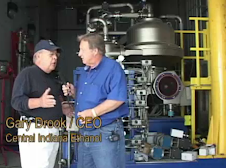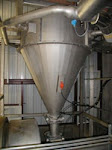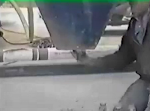Judge agrees with GreenShift - no reciever for Adrian Plant.
“Why would you need a receiver to pay the electric bill?” said Tecumseh attorney Jean Ann Seiler, objecting on behalf of Greenshift Corp. of New York, one of the parties suing the company that started the biodiesel plant.
******************
Greenshift is seeking $2.9 million in damages. YA Global Investments LP of New Jersey claims it has the first secured position for repayment of a “substantial amount of money” it loaned to Greenshift in 2008. Several contractors also have pending claims.
Dolan told the court there is a possibility there could soon be sale proceeds to divide up.
“We do have a potential purchaser we are courting,” Dolan said. “We may be back here fairly quickly with a motion to sell.”
SEE HERE
SkunK
Wednesday, March 30, 2011
GERS Watch
OTCPicks.com Stocks to Watch for Wednesday, March 30th
BGBV, DKAM, THRR, PMDP, GERS, ZVTK
SEE Newsletter HERE
SkunK
BGBV, DKAM, THRR, PMDP, GERS, ZVTK
SEE Newsletter HERE
Recent Stock Newsletters Mentioning GERS
SkunK
Saturday, March 26, 2011
BioFuelsWatch on Otter Tail Deal
Not sure if this is new reporting or just new wording gleamed from previous coverage:
"The work has already started at the plant to make it compatible with the corn oil extraction technology said Jim Stark."
**************
"Jim Stark also said the part of fermentation process will include the balance distiller grain which will be sent to the drying unit and they have also installed a unit which will extract any oil left out in the grain. This means in case of any excess of oil in the corn after the ethanol has been produced that will be taken out and saved said Jim Stark. Green Plains is planning to set up the technology by this year’s third quarter."
**************
SEE HERE
SkunK
"The work has already started at the plant to make it compatible with the corn oil extraction technology said Jim Stark."
**************
"Jim Stark also said the part of fermentation process will include the balance distiller grain which will be sent to the drying unit and they have also installed a unit which will extract any oil left out in the grain. This means in case of any excess of oil in the corn after the ethanol has been produced that will be taken out and saved said Jim Stark. Green Plains is planning to set up the technology by this year’s third quarter."
**************
SEE HERE
SkunK
Friday, March 25, 2011
The Adkins Suit
The SkunK will try to sum up the filings below. This is dangerous since I only know what I know and only see what I see - but here goes:
Adkins Energy LLC had a prior relationship with GreenShift. Generally, that relationship was as a COES customer. Presently, it is on the list of those being sued for using GreenShift's COES patent without a license. Years ago, during construction some of the contracted work was paid for by Adkins, seemingly due to GreenShift's inability to pay the sub-contractor.
Adkins paid the contractor and then went with a non-patented COES. GreenShift is still litigating the patent issue and now Adkins is suing GreenShift for the money ($130,000) that Adkins paid the subcontactor. GreenShift responds, in part, that the services Adkins paid for provided Adkins with value - value that they continue to benefit from. In any case, here is some of the related filings published together for you to take a look.
************************
Adkins' Motion for Breach of Contract Judgement HERE
Adkins' Memo in Support HERE
Mr. Baker's (Adkins CFO) Statement HERE
The GreenShift Filing in answer SEE HERE
************************
SkunK
Adkins Energy LLC had a prior relationship with GreenShift. Generally, that relationship was as a COES customer. Presently, it is on the list of those being sued for using GreenShift's COES patent without a license. Years ago, during construction some of the contracted work was paid for by Adkins, seemingly due to GreenShift's inability to pay the sub-contractor.
Adkins paid the contractor and then went with a non-patented COES. GreenShift is still litigating the patent issue and now Adkins is suing GreenShift for the money ($130,000) that Adkins paid the subcontactor. GreenShift responds, in part, that the services Adkins paid for provided Adkins with value - value that they continue to benefit from. In any case, here is some of the related filings published together for you to take a look.
************************
Adkins' Motion for Breach of Contract Judgement HERE
Adkins' Memo in Support HERE
Mr. Baker's (Adkins CFO) Statement HERE
The GreenShift Filing in answer SEE HERE
************************
SkunK
Local Media Otter Tail Update
The SkunK likes local media coverage - if for no other reason than getting some fresh quotes outside the normal PR release. Here is the Fergus Falls Journal:
“We had folks up there earlier this week actually working on getting the IT system ready for transition,” said Jim Stark, Green Plains’ vice president of media relations. He added that Green Plains is excited to have the Fergus Falls plant in its fold of producers, and work has already begun to make the plant compatible with corn oil extraction technology.
“Part of the fermentation process is that for the leftover distiller grain that would be going to the drying unit, we have installed this unit that extracts any oil that’s left in the grain,” Stark said. Practically, that means that any excess oil in the corn after ethanol is produced will be taken out and saved. “We’re getting more benefit out of that kernel of corn,” he said.
He said Green Plains expects the technology to be installed by the third quarter of this year.
SEE Complete Article HERE:
SkunK
“We had folks up there earlier this week actually working on getting the IT system ready for transition,” said Jim Stark, Green Plains’ vice president of media relations. He added that Green Plains is excited to have the Fergus Falls plant in its fold of producers, and work has already begun to make the plant compatible with corn oil extraction technology.
“Part of the fermentation process is that for the leftover distiller grain that would be going to the drying unit, we have installed this unit that extracts any oil that’s left in the grain,” Stark said. Practically, that means that any excess oil in the corn after ethanol is produced will be taken out and saved. “We’re getting more benefit out of that kernel of corn,” he said.
He said Green Plains expects the technology to be installed by the third quarter of this year.
SEE Complete Article HERE:
SkunK
Thursday, March 24, 2011
Green Plains Completes Acquisition of Otter Tail
"We will also begin the process of installing corn oil extraction technology at the Otter Tail plant, which we expect to complete by the end of the third quarter of this year.
see ALL HERE
SkunK
see ALL HERE
SkunK
Greenshift Corp: Putting the Squeeze on Corn
After a series of bankruptcies laid the U.S. ethanol industry on its back a few years ago, the survivors got the message - become economically viable or go out of business. The industry has been scrambling to adopt new processes that utilize other non-food materials or at least get more out of the corn that has been the mainstay feedstock for the U.S. ethanol industry.
Enter Greenshift Corporation (GERS) with its corn oil extraction process and a new step in the corn-ethanol production process. Greenshift may change the economics of corn-ethanol production by giving producers new revenue streams.
SEE ALL HERE
and HERE
These are new articles echoing from this original article HERE
SkunK
Enter Greenshift Corporation (GERS) with its corn oil extraction process and a new step in the corn-ethanol production process. Greenshift may change the economics of corn-ethanol production by giving producers new revenue streams.
SEE ALL HERE
and HERE
These are new articles echoing from this original article HERE
SkunK
Tuesday, March 22, 2011
GOLDEN GRAIN ENERGY, LLC UPDATE
(SkunK note: Golden Grain has a non-patented COES system)
"The average price we received for our corn oil during the first quarter of our 2011 fiscal year was approximately 39% higher than during the same period of 2010. Management attributes this increase in the average price we received for our corn oil with increased corn oil demand from biodiesel production and increased soybean oil prices which positively impacts the price of corn oil. Management anticipates that corn oil prices will continue at the recent highs as long as the world supply of commodities stay tight and the blenders credit stays in place. In addition to the increase in corn oil prices, we sold approximately 169% more corn oil during the first quarter of our 2011 fiscal year compared to the same period of 2010. Management attributes this increase in corn oil sales with improved reliability of our corn oil extraction equipment which allows us to extract more corn oil. During our 2010 fiscal year, our corn oil extraction equipment operated sporadically which reduced our total production of corn oil. Management anticipates that corn oil sales will continue at their current levels due to these recent operating improvements."
see here page 15
past posts here
and here
SkunK
"The average price we received for our corn oil during the first quarter of our 2011 fiscal year was approximately 39% higher than during the same period of 2010. Management attributes this increase in the average price we received for our corn oil with increased corn oil demand from biodiesel production and increased soybean oil prices which positively impacts the price of corn oil. Management anticipates that corn oil prices will continue at the recent highs as long as the world supply of commodities stay tight and the blenders credit stays in place. In addition to the increase in corn oil prices, we sold approximately 169% more corn oil during the first quarter of our 2011 fiscal year compared to the same period of 2010. Management attributes this increase in corn oil sales with improved reliability of our corn oil extraction equipment which allows us to extract more corn oil. During our 2010 fiscal year, our corn oil extraction equipment operated sporadically which reduced our total production of corn oil. Management anticipates that corn oil sales will continue at their current levels due to these recent operating improvements."
see here page 15
past posts here
and here
SkunK
Sunday, March 20, 2011
Tsunami
Those of you that have followed the blog for awhile might remember Mrs. SkunK and I have a small place on the Pacific coast in Japan. We normally send some pictures when we get out that way. Well, Mrs. SkunK was on advance party when the 9.0 earthquake hit. Doing some volunteer work at a kindergarten she rode it out under some tiny desks with the kids.
Parents immediately picked up their offspring and with the tsunami warnings blaring over the town's warning speakers, she was able to hoof it back home in time to take this picture. The walk back was difficult since numerous huge aftershocks kept her from walking in a straight line. I missed out on my big chance to utilize my years of stumbling experience and training.
Thanks to the blocking effects of Cape Inubō, the tsunami was only three meters or about ten feet in the local area. As you can see the local fishing fleet had scrambled out of the harbor and rode the tsunami out just off shore. You can see the water has pulled out and the wave is approaching. It ran up the local river and soaked a parking lot, with little or no local damage. There were a few more tsunami, but I think this was the largest. Aftershocks - in reality major earthquakes - continue even now.
Parents immediately picked up their offspring and with the tsunami warnings blaring over the town's warning speakers, she was able to hoof it back home in time to take this picture. The walk back was difficult since numerous huge aftershocks kept her from walking in a straight line. I missed out on my big chance to utilize my years of stumbling experience and training.
Thanks to the blocking effects of Cape Inubō, the tsunami was only three meters or about ten feet in the local area. As you can see the local fishing fleet had scrambled out of the harbor and rode the tsunami out just off shore. You can see the water has pulled out and the wave is approaching. It ran up the local river and soaked a parking lot, with little or no local damage. There were a few more tsunami, but I think this was the largest. Aftershocks - in reality major earthquakes - continue even now.
The trains soon stopped running in our area to save electricity and gas was still short due to disruptions and the refinery fire in Chiba. Although wanting to stay, there wasn't much she could do locally except consume scare resources. So Mrs. Skunk caught a bus to where the trains ran and then caught a flight home. Just in time to put another log on the fire. We both look forward to visiting Japan together - hopefully in the not too distant future. .
SkunK
Saturday, March 19, 2011
The Anderson's New Investment
The Andersons to invest $5.6 to expand Cass County enthanol plant operations
Phil Huffman, the company’s plant manager, said the investment would result in a new corn oil extraction system the would produce a more valuable byproduct that would net the company an additional 40 cents a pound.
“The oil project is to extract corn oil from the process to sell it as a value-added product,” he said.
SEE HERE
SkunK
Phil Huffman, the company’s plant manager, said the investment would result in a new corn oil extraction system the would produce a more valuable byproduct that would net the company an additional 40 cents a pound.
“The oil project is to extract corn oil from the process to sell it as a value-added product,” he said.
SEE HERE
SkunK
Sunday, March 13, 2011
RFS2 Advanced Technology
Ethanol Producer Magazine
EPA made an important change to the corn oil extraction technology requirement in its December rule revisions, removing earlier language that limited extraction to thin stillage and DGS. EPA decided that “a more straightforward approach to specifying the required application of corn oil extraction in the regulations would be to identify the amount of oil that must be extracted.” This approach allows producers to apply corn oil extraction “as they see fit, providing only that the requisite quantity of oil is extracted.” Although it provides more flexibility to the producer using this technology to generate RINs, there is some question regarding its feasibility.
EPA made an important change to the corn oil extraction technology requirement in its December rule revisions, removing earlier language that limited extraction to thin stillage and DGS. EPA decided that “a more straightforward approach to specifying the required application of corn oil extraction in the regulations would be to identify the amount of oil that must be extracted.” This approach allows producers to apply corn oil extraction “as they see fit, providing only that the requisite quantity of oil is extracted.” Although it provides more flexibility to the producer using this technology to generate RINs, there is some question regarding its feasibility.
Although corn oil extraction is perhaps the most attractive of the five technologies because of its relatively low cost, the 1.33 pounds-per-bushel minimum is not achievable at this time. In fact, the corn oil extraction requirement joins membrane separation and raw starch hydrolysis as technically unfeasible stand-alone options, leaving only CHP and fractionation as alternatives. Concerns exist, however, regarding the economic feasibility of CHP with one commenter informing EPA that the cost necessary to meet the CHP advanced technology standard would make it “commercially unviable.” In response, EPA noted that it did not consider cost in its considerations of applicable advanced technologies. Without considering cost or commercial availability (EPA focused on technology requirements that would be in place by 2022), dry mill facilities have few realistic compliance options. Fortunately, EPA recently confirmed that it would allow a plant to use fractionation and extraction together to meet the 1.33 pounds-per-bushel threshold to meet the advanced technology requirement.
Wednesday, March 9, 2011
Saturday, March 5, 2011
Virmmac.com
Inside the GPRE 10K
We all know that corn oil can be used as a feedstock for biodiesel. Like petroleum based fuels - this use as a fuel - seems to be its base use and keeps a floor under its price. Yet, also like oil it has many more "higher value" uses. These higher value uses are normally just described as "other industrial uses" or some such other catch all phrase. Here in the GPRE 10K we get a rare detailed list of these other high value uses that support corn oil's present high commodity price. It appears they might be listed in order of importance?
"Industrial uses for corn oil include feedstock for biodiesel, livestock feed additives, rubber substitutes, rust preventatives, inks, textiles, soaps and insecticides."
Here is the quote in two different contexts:
Recently, we began implementing corn oil extraction technology at our six legacy ethanol plants. The corn oil system is designed to extract non-edible corn oil from the whole stillage process immediately prior to production of distillers grains. Industrial uses for corn oil include feedstock for biodiesel, livestock feed additives, rubber substitutes, rust preventatives, inks, textiles, soaps and insecticides. We expect the implementation of corn oil extraction at our plants will cost us approximately $18.0 million in the aggregate with completion by the end of the second quarter of 2011. At December 31, 2010, we were operating corn oil extraction systems at our Lakota, Obion, Ord and Riga plants. Because the value of the corn oil as an extracted product is currently greater than its value as a component of distillers grains, we believe the implementation of corn oil extraction at our plants will provide a new revenue stream with greater value-added economics. (page 40)
************************
Here is another:
Recently, we began implementing corn oil extraction technology at our six legacy ethanol plants. We expect the implementation of corn oil extraction at our plants will be completed by the end of the second quarter of 2011. As of December 31, 2010, we were operating corn oil extraction systems at our Lakota, Obion, Ord and Riga plants. The corn oil systems are designed to extract non-edible corn oil from the thin stillage evaporation process immediately prior to production of distillers grains. Corn oil is produced by processing syrup and evaporated thin stillage, through a decanter style centrifuge or a disk stack style centrifuge. Corn oil has a lower density than water or solids which make up the syrup. The centrifuges separate the relatively light oil from the heavier components of the syrup, eliminating the need for significant retention time. De-oiled syrup is returned to the process for blending into wet, modified, or dry distillers grains. The corn oil product is primarily marketed as a livestock feed supplement or to the biodiesel market.
Industrial uses for corn oil include feedstock for biodiesel, livestock feed additives, rubber substitutes, rust preventatives, inks, textiles, soaps and insecticides. Our corn oil is primarily sold to biodiesel manufactures and, to a lesser extent, feed lot and poultry markets. We generally transport our corn oil by truck to locations in a close proximity to our ethanol plants, primarily in the southeastern and midwestern regions of the U.S. (page 10)
GPRE 10-K Here Dated 4 Mar
SkunK
"Industrial uses for corn oil include feedstock for biodiesel, livestock feed additives, rubber substitutes, rust preventatives, inks, textiles, soaps and insecticides."
Here is the quote in two different contexts:
Recently, we began implementing corn oil extraction technology at our six legacy ethanol plants. The corn oil system is designed to extract non-edible corn oil from the whole stillage process immediately prior to production of distillers grains. Industrial uses for corn oil include feedstock for biodiesel, livestock feed additives, rubber substitutes, rust preventatives, inks, textiles, soaps and insecticides. We expect the implementation of corn oil extraction at our plants will cost us approximately $18.0 million in the aggregate with completion by the end of the second quarter of 2011. At December 31, 2010, we were operating corn oil extraction systems at our Lakota, Obion, Ord and Riga plants. Because the value of the corn oil as an extracted product is currently greater than its value as a component of distillers grains, we believe the implementation of corn oil extraction at our plants will provide a new revenue stream with greater value-added economics. (page 40)
************************
Here is another:
Recently, we began implementing corn oil extraction technology at our six legacy ethanol plants. We expect the implementation of corn oil extraction at our plants will be completed by the end of the second quarter of 2011. As of December 31, 2010, we were operating corn oil extraction systems at our Lakota, Obion, Ord and Riga plants. The corn oil systems are designed to extract non-edible corn oil from the thin stillage evaporation process immediately prior to production of distillers grains. Corn oil is produced by processing syrup and evaporated thin stillage, through a decanter style centrifuge or a disk stack style centrifuge. Corn oil has a lower density than water or solids which make up the syrup. The centrifuges separate the relatively light oil from the heavier components of the syrup, eliminating the need for significant retention time. De-oiled syrup is returned to the process for blending into wet, modified, or dry distillers grains. The corn oil product is primarily marketed as a livestock feed supplement or to the biodiesel market.
Industrial uses for corn oil include feedstock for biodiesel, livestock feed additives, rubber substitutes, rust preventatives, inks, textiles, soaps and insecticides. Our corn oil is primarily sold to biodiesel manufactures and, to a lesser extent, feed lot and poultry markets. We generally transport our corn oil by truck to locations in a close proximity to our ethanol plants, primarily in the southeastern and midwestern regions of the U.S. (page 10)
GPRE 10-K Here Dated 4 Mar
SkunK
Echos from Adrian
GreenShift's prior management/plan to purchase a biodiesel plant in Michigan continues to echo in the Michigan court system. We should have an update in the Annual Report due in April.
See Here
SkunK
See Here
SkunK
Friday, March 4, 2011
Getting the Word Out
With "successful" in the title and "corn oil extraction" in the first paragraph - its has to be good! Getting the word out to the Ethanol Industry. Nothing will bring success to GreenShift like the success our customers.
SEE HERE
SkunK
SEE HERE
SkunK
Thursday, March 3, 2011
GPRE Reports 4Q as of 2 March
Here are some tidbits - search for "corn oil" [edit, find on this page] then you can scan for all these quotes: SEE HERE
****************
The Company sold approximately 5.0 million pounds of corn oil in the fourth quarter of 2010.
In July 2010, Green Plains announced plans to implement corn oil extraction technology at its ethanol plants. At the end of 2010, Green Plains had installed the technology at two plants and recently completed the installation at a third plant. The Company expects to complete the technology deployment by the end of second quarter 2011.
“As we grow, we are keenly focused on the diversification of our cash flows. Implementation of corn oil extraction at our plants is a prime example of this strategy. We expect to have all of our ethanol plants producing corn oil by the end of the second quarter of this year. Once fully implemented, this project has the potential to produce more than 100 million pounds of corn oil and generate incremental operating income in excess of $30 million annually, based on current market prices,” Becker commented. “We expect to generate at least $50 million of total operating income annually from corn oil production, our agribusiness operations, and marketing, blending and distribution activities.”
Operating Segment Information
Green Plains’ operating segments are as follows: (1) production of ethanol and related distillers grains, collectively referred to as ethanol production, (2) grain warehousing and marketing, as well as sales and related services of agronomy and petroleum products, collectively referred to as agribusiness, and (3) production and sales of corn oil, along with the marketing and distribution of Company-produced and third-party ethanol and distillers grains, collectively referred to as marketing and distribution. Selling, general and administrative expenses, primarily consisting of compensation of corporate employees, professional fees and overhead costs not directly related to a specific operating segment are reflected in the table below as corporate activities.
**************************
SkunK
****************
The Company sold approximately 5.0 million pounds of corn oil in the fourth quarter of 2010.
In July 2010, Green Plains announced plans to implement corn oil extraction technology at its ethanol plants. At the end of 2010, Green Plains had installed the technology at two plants and recently completed the installation at a third plant. The Company expects to complete the technology deployment by the end of second quarter 2011.
“As we grow, we are keenly focused on the diversification of our cash flows. Implementation of corn oil extraction at our plants is a prime example of this strategy. We expect to have all of our ethanol plants producing corn oil by the end of the second quarter of this year. Once fully implemented, this project has the potential to produce more than 100 million pounds of corn oil and generate incremental operating income in excess of $30 million annually, based on current market prices,” Becker commented. “We expect to generate at least $50 million of total operating income annually from corn oil production, our agribusiness operations, and marketing, blending and distribution activities.”
Operating Segment Information
Green Plains’ operating segments are as follows: (1) production of ethanol and related distillers grains, collectively referred to as ethanol production, (2) grain warehousing and marketing, as well as sales and related services of agronomy and petroleum products, collectively referred to as agribusiness, and (3) production and sales of corn oil, along with the marketing and distribution of Company-produced and third-party ethanol and distillers grains, collectively referred to as marketing and distribution. Selling, general and administrative expenses, primarily consisting of compensation of corporate employees, professional fees and overhead costs not directly related to a specific operating segment are reflected in the table below as corporate activities.
**************************
SkunK
Subscribe to:
Posts (Atom)











